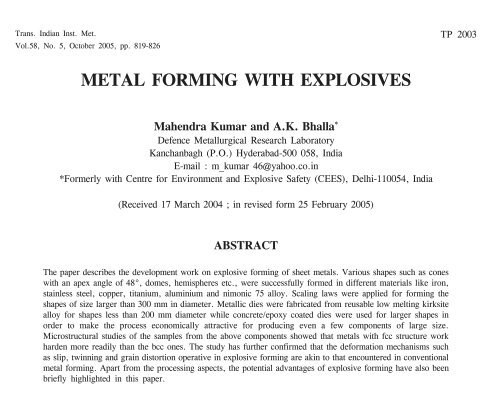Vol.58, No. 5 - Indira Gandhi Centre for Atomic Research
Vol.58, No. 5 - Indira Gandhi Centre for Atomic Research
Vol.58, No. 5 - Indira Gandhi Centre for Atomic Research
You also want an ePaper? Increase the reach of your titles
YUMPU automatically turns print PDFs into web optimized ePapers that Google loves.
Trans. Indian Inst. Met.<br />
<strong>Vol.58</strong>, <strong>No</strong>. 5, October 2005, pp. 819-826<br />
TP 2003<br />
METAL FORMING WITH EXPLOSIVES<br />
Mahendra Kumar and A.K. Bhalla *<br />
Defence Metallurgical <strong>Research</strong> Laboratory<br />
Kanchanbagh (P.O.) Hyderabad-500 058, India<br />
E-mail : m_kumar 46@yahoo.co.in<br />
*Formerly with <strong>Centre</strong> <strong>for</strong> Environment and Explosive Safety (CEES), Delhi-110054, India<br />
(Received 17 March 2004 ; in revised <strong>for</strong>m 25 February 2005)<br />
ABSTRACT<br />
The paper describes the development work on explosive <strong>for</strong>ming of sheet metals. Various shapes such as cones<br />
with an apex angle of 48°, domes, hemispheres etc., were successfully <strong>for</strong>med in different materials like iron,<br />
stainless steel, copper, titanium, aluminium and nimonic 75 alloy. Scaling laws were applied <strong>for</strong> <strong>for</strong>ming the<br />
shapes of size larger than 300 mm in diameter. Metallic dies were fabricated from reusable low melting kirksite<br />
alloy <strong>for</strong> shapes less than 200 mm diameter while concrete/epoxy coated dies were used <strong>for</strong> larger shapes in<br />
order to make the process economically attractive <strong>for</strong> producing even a few components of large size.<br />
Microstructural studies of the samples from the above components showed that metals with fcc structure work<br />
harden more readily than the bcc ones. The study has further confirmed that the de<strong>for</strong>mation mechanisms such<br />
as slip, twinning and grain distortion operative in explosive <strong>for</strong>ming are akin to that encountered in conventional<br />
metal <strong>for</strong>ming. Apart from the processing aspects, the potential advantages of explosive <strong>for</strong>ming have also been<br />
briefly highlighted in this paper.
















